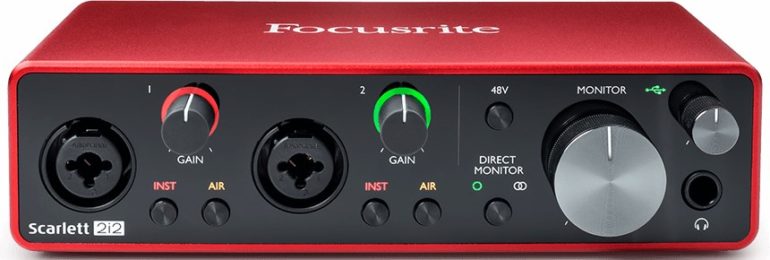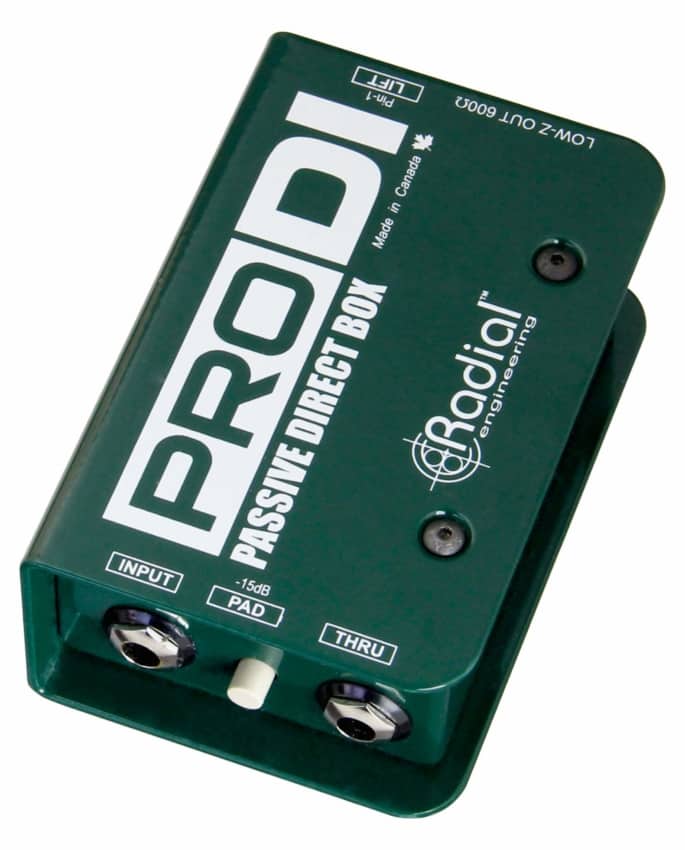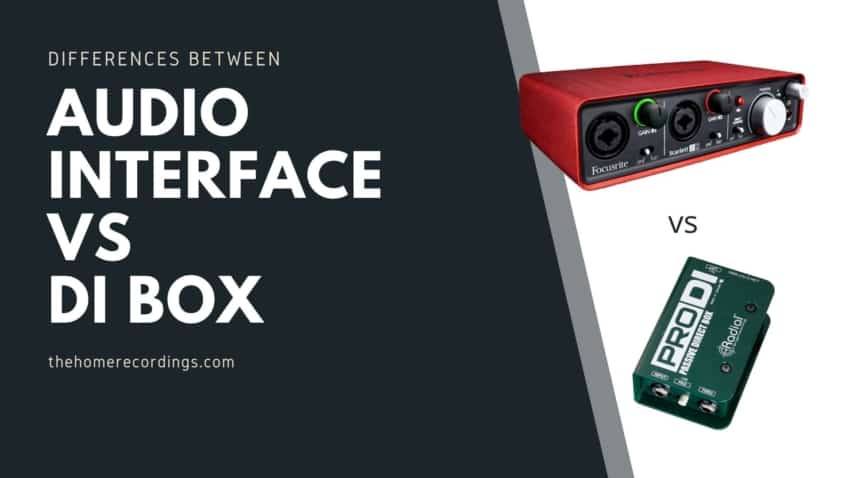Last updated on December 31st, 2023 at 06:01 pm
Most of us know what an Audio Interface is, or at least have a slight idea of how it actually works, but what is a DI box and which one should you choose?
In this post I will go over what they are, what they are designed for, and when you should get one or the other.
So, without further ado, let’s get into it!
What is an Audio Interface?

An audio interface is an important piece of hardware which is used to input and output audio to and from your PC. A doorway of such in and out of the realm of digital audio, allowing you to record music into your DAW and monitor the music coming out of it.
Along with microphones, monitors, and headphones, the interface is an essential weapon in your audio arsenal. The most common way of connecting it to your computer is through USB cable, but there are several methods available including Firewire and PCI.
Although audio interfaces vary vastly in terms of capabilities, there are a few commonalities you will find across most of them.
The first feature you will become acquainted with are the input jacks. These can be a mixture of TRS and XLR connections, but it’s becoming increasingly more common to see combo jacks which are compatible with both TRS and XLR connectors.
These allow you to plug microphone (XLR) and line level (TRS) sources into the interface. Some also feature the ability to plug instruments in through a type of input named a DI (we’ll go into more detail on that in bit).
The next feature to take note of is called 48-volt phantom power. If the microphone you are using is a condenser you will need this external power for the circuitry inside the mic to operate.
Through the simple press of a button your condenser now turns from an ornament to opulent.
The next internal feature you will come across are the preamplifiers. Because microphones output a signal which is extremely low it is necessary to boost it with the use of an internal amplifier.
You will be able to adjust the gain (strength of the signal) on the preamp by using rotary knobs, referred to as pots, which are found on the front of your interface.
The more you rotate the pot clockwise the more powerful your signal will become, and although you want a strong signal too much gain will lead to distortion.
Another essential part of the audio interface are its A/D and D/A converters. After your inputs are plugged in and gain adjustments are made, sound is converted to binary through an analog to digital (A/D) converter.
This binary data then enters your DAW and is recorded and ready to be processed to your desire. The digital to analog (D/A) converter on the other hand does the complete reverse of the A/D converter.
It converts these 1s and 0s back into analog signals. These signals then travel through the final feature of the interface we will mention.
Last but not least, the output jacks. These are typically TRS jacks found on the back of your interface. Monitors and headphones are the most common pieces of equipment you will output your audio to.
Your sounds will be back in the acoustic domain and ready for you to mix to taste.
How much does an Audio Interface Cost?
Audio interfaces can be found everywhere from the most prestigious professional studio to the dingiest tight-budget bedroom studio, and as such the prices vary greatly. But fear not, there are many options available that won’t break the bank.
The Behringer U-Phoria UM2 comes with a mic/line level input and an instrument input. It’s a bargain at only $45, but the preamp sounds anything but cheap thanks to some cost-efficient German engineering.
If you needed more inputs, then Japanese juggernauts Roland’s Rubix44 might be the choice for you. With 4 combo inputs plus a built-in compressor/limiter, this little beauty would be perfect for recording those jam sessions in the garage that your neighbours hate so much. It will set you back $300.
Maybe you’ve finally got around to building a project studio. Treat yourself to a bit of British class with the Focusrite 18i20. It includes 8 combo inputs, 10 outputs, 4 digital input connections, and a built-in talkback microphone.
This workhorse will help the creative juices stay flowing in your recording sessions. The damage on one of these is $500.
These are all affordable interfaces which will more than satisfy the aspiring sound enthusiast, but at least one model on the opposite end of the price spectrum deserves a mention.
The RME Madiface XT costs $2650 and boasts the capability of handling a whopping 196 inputs and 198 outputs of audio. Maybe keep it in mind for the future in case you are ever recording an artist’s indulgent prog-rock magnum opus. Hopefully not.
What is a DI Box?

A direct input box (input, injection, insertion, take your pick) is a piece of hardware which allows you to plug instruments into the preamplifiers on your interface or mixer.
The box contains a ¼” jack input for your instruments, an XLR output for connecting to your preamp, and another jack which allows you to pass the input signal to an amplifier. It is also common for them to feature a ground lift switch which is used to eliminate ground hum.
Besides the connector matching, there are three main reasons for using a DI box. The first is to convert an unbalanced signal to a balanced one. A balanced signal contains a positive, a negative, and a ground path.
An unbalanced only contains a positive and a ground path. This might all sound a bit boring to you, so just try to remember that unbalanced signals are more susceptible to noise interference and weakening.
The second purpose of the box is to convert a high impedance signal to a low impedance signal. Impedance is resistance to the flow of alternating current. A simplified way of describing impedance would be using an analogy of water flowing through a hose.
If you squeezed tightly on the hose the water would struggle to flow, this would be a high impedance signal. If you released your grip the water would flow more freely, this would be a low impedance signal.
The third common use of the box involves the use of the ground lift feature. In audio when there are too many ground paths available for a signal it creates an annoying buzzing noise, so with the use of its internal isolation transformer a DI box solves this problem for you.
Different Types of DI Boxes
There are two different types of DI boxes. They do the same job, the difference between them lies within their circuitry.
Active DI Box
An active DI box contains a preamplifier, and you will be able to tell it’s an active because it needs a power supply. An internal battery, external power supply, or 48-volts phantom power are all options which may be available depending on the box.
The general rule of thumb you want to remember is passive instruments require an active DI. For example, if you wanted to use a DI with a Fender Stratocaster, you would reach for your active DI.
Passive DI Box
Passives on the other hand are simply an audio transformer and require no power to operate. Conversely, what you want to remember is active instruments require a passive DI. For example, a keyboard like the classic Roland Juno-106 would be better suited for a passive DI.
How much does a DI Box Cost?
Prices vary from low to high with DI boxes, but you will find the reasonably priced industry standards are more than adequate for home studios and live performances.
Behringer’s Ultra-DI DI400 P-1 is craftily built but as cheap as chips at $20.
The active BSS AR133 will only set you back $195, but it does anything but cheapen your signal.
And of course, lest we forget, the dons of the DI world Radial Engineering offer their passive RADIAL JDI for $200.
Do you need a DI Box with an Audio Interface?
As mentioned, many audio interfaces come with DI inputs, the problem is there is usually a limited amount of these, so if you intend on having more DI signals than you have inputs you will need to invest in a stand-alone box.
Another reason to pick up one is the fact is that a lot of the built in DI inputs on interfaces just simply aren’t up to scratch quality wise when compared to stand-alone boxes in their equivalent price range.
When do you need a DI box?
You will run into numerous situations where you discover a DI is a necessity, not an accessory.
Maybe mic bleed is causing the phantom menace that is phase cancellations to rear its ugly head. DI to the rescue.
Long unbalanced cable runs are susceptible to weakening of their signals, so converting these signals to balanced ones will be in your best interest.
The ground lift feature found on most boxes will be a complete life saver if that issue ever arises (and it will!).
There is also the convenience factor of a DI box in a live environment which is often overlooked. Let’s say for instance, you’re playing in the battle-of-the-bands at your local over-priced and under-staffed bar.
You find yourself preforming on a tiny stage and although your acoustic guitar may sound like it was carved from the high heavens themselves when played through your $1000 Neumann condenser microphone, do you really want to risk the chance of an overzealous bass player knocking it over and smashing that small mortgage of a mic to pieces? This is where the DI box comes into play.
